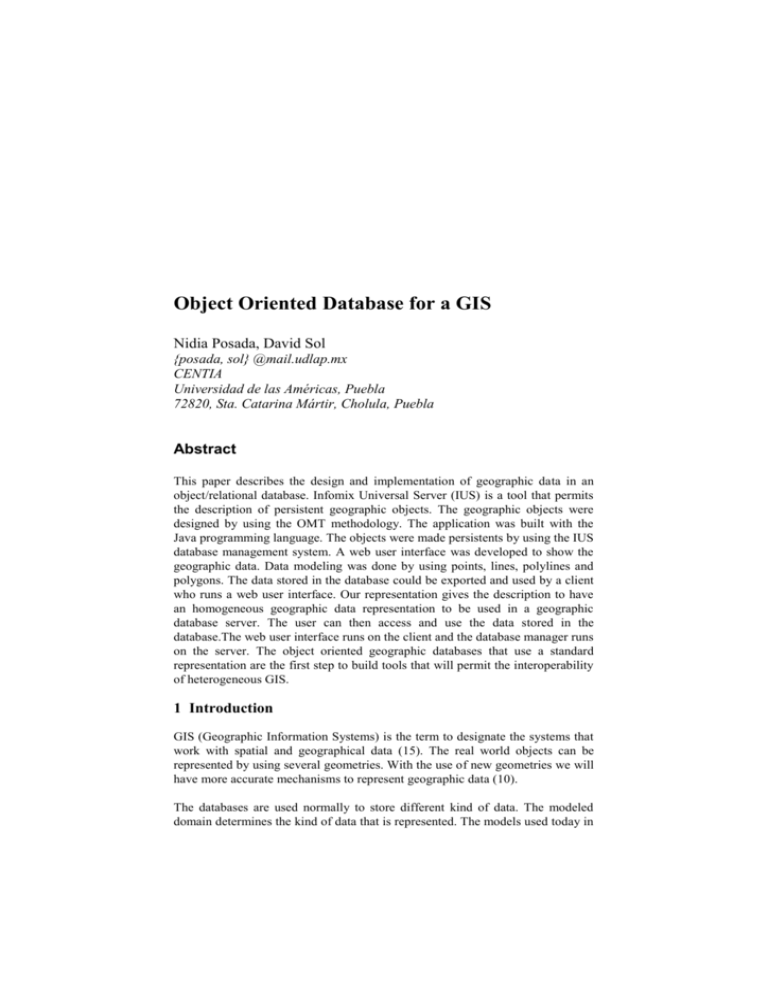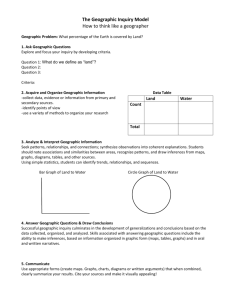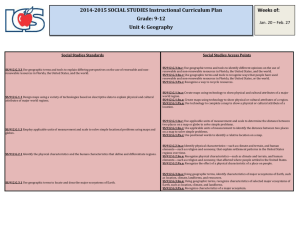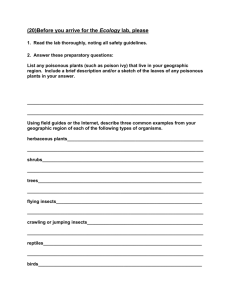Oriented Object Database for a GIS - ICT
advertisement

Object Oriented Database for a GIS
Nidia Posada, David Sol
{posada, sol} @mail.udlap.mx
CENTIA
Universidad de las Américas, Puebla
72820, Sta. Catarina Mártir, Cholula, Puebla
Abstract
This paper describes the design and implementation of geographic data in an
object/relational database. Infomix Universal Server (IUS) is a tool that permits
the description of persistent geographic objects. The geographic objects were
designed by using the OMT methodology. The application was built with the
Java programming language. The objects were made persistents by using the IUS
database management system. A web user interface was developed to show the
geographic data. Data modeling was done by using points, lines, polylines and
polygons. The data stored in the database could be exported and used by a client
who runs a web user interface. Our representation gives the description to have
an homogeneous geographic data representation to be used in a geographic
database server. The user can then access and use the data stored in the
database.The web user interface runs on the client and the database manager runs
on the server. The object oriented geographic databases that use a standard
representation are the first step to build tools that will permit the interoperability
of heterogeneous GIS.
1 Introduction
GIS (Geographic Information Systems) is the term to designate the systems that
work with spatial and geographical data (15). The real world objects can be
represented by using several geometries. With the use of new geometries we will
have more accurate mechanisms to represent geographic data (10).
The databases are used normally to store different kind of data. The modeled
domain determines the kind of data that is represented. The models used today in
a database assure consistensy, security, reduce redundancy and permit the
concurrent access. The data stored in a database is different from the data used in
a real world. Mechanisms to store and to retrieve data must be developed.
The development of the object oriented paradigm programming suggests the use
of the object oriented approach to be considered in a database. The object
oriented DBMS are created to support CAD applications, multimedia systems
like GIS and to handle voice, video and normal data. This paper describes the use
and management of geographic objects in a database. The DBMS used is the
object/relational Informix module. A web user interface developed in our
research group (3) presents the geographic data. The interface manages several
GIS aspects like pan, geometric operations (translation, zoom), scales and
coordinates. Our work can be a platform to test other aspects like queries,
interoperability and sharing of geographic data.
2 Related work
The research developed in this area shows specific and general characteristics.
An important aspect is the fact that interoperability needs the use of a standard
format for geographic data. The general characteristics show that there is an
interest to establish a standard. We try to indentify the important aspects to be
included in our work. Table 1 shows the works that have been analyzed with
their principals properties.
Display
Propagation
Inheritance
Association
Aggregation
Generalizaition
Model
Classification
The principal characteristics are: aggregation, association, generalization,
classification and inheritance. In particular (5) shows how the inheitance and the
association are modeled.
Object-Oriented Modeling for GIS (5)
Rock & Roll (6)
Computer Cartography for GIS: an Object-Oriented
view on the Display Transformation (1)
Object Oriented Modeling for Geography
Information System (OOGIS) (12)
Table 1 Features of work analyzed and system OOGIS proposed
3 Methodology
We used the OMT methodology (13) because it has the facility to manage
objects in the design step. These objects can be used in programming and
databases in the object oriented approach. Our goal is to handle geographic
objects in three levels: design, programming and databases. At the same time we
keep the advantages offered by the relational model.
4 Data Model
Two approaches were considered to implement our ideas:
object oriented database systems
object/relational database systems
First we will describe some aspects of the relational approach that permit to
understand easily the advantages of the object/relational approach.
4.1 Relational model
The relational model is very popular because this is a very simple approach. It
has only one structure: a table with tuples and attributes with atomic data types.
The query language uses simple operations on the tables and the more complex
like joins don´t need be understood by users (4). If the relational model is used
the data needs to be atomized in rows and columns. The mechanisms to store and
to retrieve data in the databases needs to be developed. To model one or two
geographic objects the representation can use 4 or 5 relational tables. A GIS
handles its data by layers. A map can be composed by rivers, roads and cities.
Each kind of geographic object is represented by a layer. In this context to model
several layers means that an important number of tables need to be implemented.
For instance, a polygon is modeled by three or more segments and each segment
is modeled by two points. The tables to model polygons, segments and points
should be created. This kind of representation reduces the data clarity. It is
possible to guarantee integrity and consistency but at the expense of clarity. The
object oriented approach propose an option that tries to keep integrity and
consistency but also clarity in the representation.
4.2 Object oriented model
This approach was inspired from the object oriented programming languages.
The principal object oriented languages are Smalltalk, C++ and Java (2). The
object oriented paradigm includes the abstract data type concept. The abstract
data type declarations are public or private. In an object oriented language the
types are implemented by classes. The object operations can also be public or
private. An object is a black box, that is built and modified independently of
other objects. As the object oriented paradigm is developed new approaches are
proposed to implement the concepts related to the object paradigm. Each
approach can manage several object concepts in a different way (8). An example
are the tools offered by an object oriented language to implement encapsulation.
The approach used to model the objects could have an influence on the object
management in the database.
4.3 Object/Relational model
The more direct way to implement objects in a database and to keep the DBMS
advantages is the Object/Relational model (14). A standard for a multimedia data
manager is developed in the context of the SQL standard (11). To manage
geographic data in an object database, the data types are first created. A
hierarchy is used to represent from the basic data types to the more complex. All
the data types are then implemented by classes in an object oriented language
programming. In the context of an object database the data that reference the data
types is stored in tables, but the structure of the data is represented by the types.
5 Geographic objects
The basic geographic objects that we use are:
points
lines
polylines
polygons
Every kind of object is modeled by an abstract data type. We use the vectorial
geometry to represent the geographic objects. This kind of modeling matchs the
representation used by the user interface. The geometry used in the interface and
in the database is based on standard geographic data. The database and the
interface shall be used in the context of an interoperability GIS. Figure 1 shows
how the basic geographic objects are used to model the Universidad de las
Américas campus.
Figure 1 UDLA Campus
6 OOGIS model
The principal contribution of our work is the implementation of persistence for
geographic objects. Figure 2 shows the class hierarchy. It shows in the first level
the View class. Each View class is formed by several layers. In the second level
we then represent the Layer class. Each Layer class can be modeled by one and
only one data type. A brief description of the geographic objects is the following:
Point: It is composed by two coordinates X and Y.
Line: A line is composed by two points, it means two pairs of X,Y
coordinates. The aggreation of two points permits the creation of one line.
From the Line class other more specific classes can be derived. These
classes manage more attributes, for instance a straight road can be modeled
by a line. The road name, the road number and the county are examples of
descriptive data.
Polyline: A polyline is composed by two or more lines. A polyline is an
aggregation of lines. Like a line, a polyline can derive more specific classes.
The river class is an example of an object that is a polyline. Descriptive
attributes are used to model additional information.
Polygon: A polygon is similar to a polyline but it is closed. The basic
geographic data polygone doesn´t give a description for a map. More
specific types (derived from polygon), like lakes, states or other object that
can be represented by a polygon, will give descriptive map information.
Layer: A layer is composed by the aggregation of two or more objects of
the same type. For instance, the lake layer, the road layer and the county
layer.
Figure 2 OOGIS Class Hierarchy, OMT design (4)
View: A view is composed by the aggregation of two or more layers. The
view class manages the activation of layers for edition. In this case it is
possible to add new geographic objects. In our application, this class
manages a method to do the intersection of two classes. The next section
describes how all the objects are organized in the database.
7 Database construction
The database is composed by two parts, the data type description and the tables.
The tables make reference to data types to describe their structure. The data type
description shows their attributes. The objects are stored in the tables, but they
make reference to the corresponding data types for their description.
Name
Type Table
Variable
point_t
layer_t
Yes
Yes
Yes
Yes
x, y
name, color, type
layerpoint_t
layerline_t
layerpolyline_t
Yes
Yes
Yes
Yes
Yes
Yes
x, y
end1, end2
num, end1, end2
Yes
name_view,
name_layer
name_layer, type
view
layer
Yes
Inheritance
layer_t
layer_t
layer_t
Association
point_t
point_t
view
Table 2 OOGIS Types and Table used
The principal types used by our application are point and line. The types polyline
and polygon are formed by aggregations of the basic types. More complex types
are formed by inheritance and association. Table 2 shows the data type name, the
attributes and the relationships with the other data types. The tables of the
database will be created by reference on the data types. Two basic tables were
created: View and Layer. These tables are built independently of any type. The
View table manages the name of the layers to describe a map. The Layer table is
responsible to manage its type. This table provides the access for any layer on
the map.
8 Prototype
Our model was tested by using the Java object oriented language program and
IUS DBMS (7) on Solaris. Our application has the following modules:
the operations manager
the database server
the interface manager
the modeling manager
Our prototype was tested with data from the Universidad de las Americas,
campus. The prototype architecture is shown in figure 3. An example of the
creation of tables and the data insertion is as follows:
create table Circuit of type layerpolyline_t;
insert into Circuit values ('Circuit','java.awt.Color[r=0,g=0,b=0]','polygon',0,
row(108,93)::point_t, row(80,95)::point_t);
create table Building of type layerpolyline_t;
insert
into
Building
('Building','java.awt.Color[r=0,g=0,b=255]','polygon',0,row(58,69)::point_t,
row(79,70)::point_t);
values
The spatial data are stored in the database in three steps:
1.
2.
3.
The layer names are associated to one project name. The table that
implements the view type store the layer and project name association. This
operation is done by the save method which belongs to the view class.
The view class save method calls the layer class save method. This method
first stores in the layer table (which implements the layer class) the type and
the name of the layer.
The same method (layer class save method) creates the table to store the
layer attributs like color, name and description data type. This table
implements the different geographic object data types (point, line, polyline,
polygon). For each layer the method generates one table.
Figure 3 OOGIS Architecture
The types created in the database match the classes implemented in Java. It is
possible to see that the types, the classes and the tables have a homogeneous
description. The types described in the database are the same that the types
described by the OMT design. With the use of a standard for geographic data
like OpenGis types our approach will be tested widely. In particular
interoperability and data exchange can be improved by this kind of
representation.
The user interface is shown in the figure 4. It is possible to see the tools to
manage zoom, pan and the geometric operations. On the right it is possible to
control the layer activation for quering and edition. The application manages
only a property format (points, lines, polylines and polygons). Actually it is
modified to manage the geographic data in the OpenGIS format (9). A module to
translate from shp ArcView is actually developed and very soon the applications
will be capable to manage (in the database and in the interface) geographic data
imported from ArcView. The application will be then capable to sopport several
database users.
Figure 4 OOGIS Interface
9 Conclusion
Our principal goal is a transparent management of geographic objects in a
database. The geographic objects can then be persitent objects. The objects don´t
need to be stored and retrieved by the use of specific mechanisms. The data types
created in the context of the database are referenced by the tables. The data types
are implemented by classes in the context of the application. The previous work
implemented geographic objects in applications but they don´t manage the
persistence. The number of access to the database can be reduced. We think that
the clarity of the representation is also improved. The objects represented in the
database are objects that can be exported and shared with other applications. In
particular, the use of a standard representation permits this interoperability.
Actually our group works in the implementation of geographic objects in our
database modeled in the OpenGIS standard representation. Heterogeneous
applications could then share geographic objects.
Our application at this stage is a prototype. The performance seems good. For
not complex geometric objects the data can be stored and retrieved in seconds.
For complex objects in the case of remote connection our prototype depends on
the network performance.
10 Bibliography
[1] Andrew U. Frank, Max J. Egenhofer, Computer Cartography for GIS: an
Object-Oriented view on the Display Transformation, Computer &
Geociences Vol 18, No.8 pp 975-987, 1992.
[2] Berard,
Edward
V.
Basic
Object-Oriented
Concepts,
http://www.toa.com/pub/html/oobasics/oobasics.html, 1996.
[3] Briones del Río, Juan Luis, Interfaz gráfica para un Sistemas de
Información Geográfico, Computer Engineer thesis, UDLA, December
1998.
[4] Cattell, Roderic Geoffrey Galton, Object Data Management: ObjectOriented and Extended Relational Database Systems, Addison-Wesley,
United States of America, 1991.
[5] Egenhofer Max J., Frank Andrew U., Object-Oriented Modeling for GIS,
URISA Journal, 1998.
[6] Fernandes, Alvaro A. A., Paton, W. Norman, Howard Williams M., A
Logical Query Language for an Object-Oriented Data Model,
Department of Computing and Electrical Engineering, Heriot-Watt
University, Edinburgh, UK, January 1999.
[7] Informix Software, Inc. Answer on line, http://ict2.udlap.mx/informix/,
1997.
[8] Khoshafian Setray, Abnous Razmik, Object Orientation, Second Edition,
Jhon Wiley & Suns, Inc., United States of America, 1995.
[9] Kottman,
Cliff,
OpenGis,
Open
Gis
Consortium,
Inc.,
http://www.opengis.org, 1995.
[10] López Ornelas, Erick de Jesús, Modelación de Información Espacial y
Geográfica, Computer Engineer thesis, UDLA, May 1998.
[11] Manola, Frank,
Sutherland, Jeff,
SQL3 Object Model,
http://www.objs.com/x3h7/sql3.html, 1997.
[12] Posada Toledo, Nidia, Modelado de Datos Orientado a Objeto para un
Sistema de Información Geográfica, Computer Engineer thesis, UDLA;
May 1999.
[13] Rumbaugh James, Blaha Michael, Premerlani William, Eddy Frededick,
Lorensen William, Modelado y diseño orientados a objetos, Prentice Hall,
Spain, 1996.
[14] Stonebraker, Michael, Paul Brown, Object Relation DBMS, Ed. MorganKaufmann, 1999.
[15] Vélez Macías, Fabio., Introduction to GIS, University of Antioquia,
Department
of
Enviroment
and
Health
Engineer,
http://quimbaya.udea.edu.co/~fabiovel/, Medellín, September 1999.








